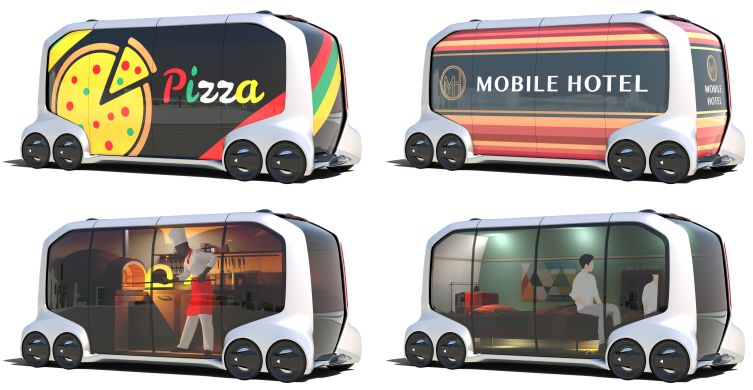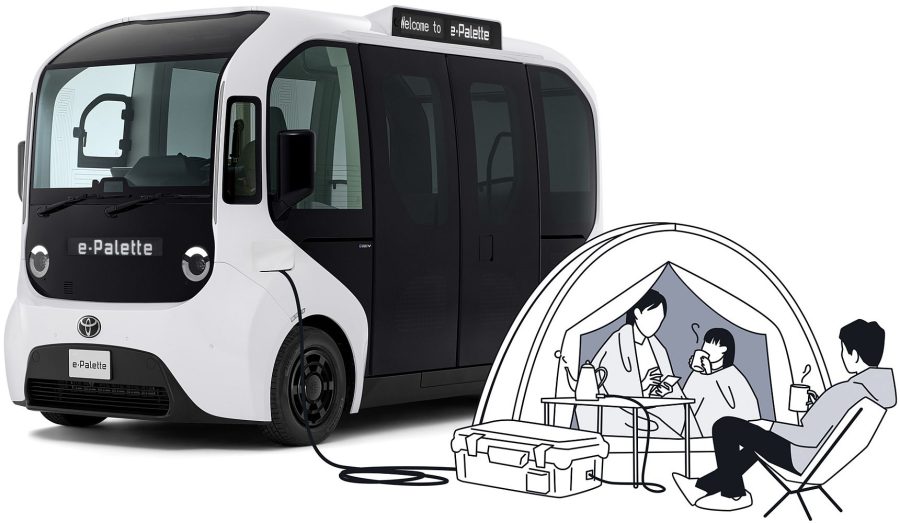The Toyota e-Palette is a symbol of our transition from auto-maker to mobility provider, a vehicle that goes beyond the scope of cars to offer new services and value. Now in its second generation, it is a fully automated battery-electric vehicle, designed to be scalable and customisable for a range of mobility services – as if creating colours by mixing paints on a palette.

Toyota e-Palette: original concept
First announced by Akio Toyoda as a concept at the 2018 Consumer Electronics Show, the Toyota e-Palette had a flat, open-plan interior layout and low floor that could be configured in multiple ways. Equipment could be installed in accordance with the user’s needs, from a ride-sharing layout to becoming a mobile hotel room, office or workshop. Toyota also proposed collaborations with retail and hospitality outlets, thereby transforming e-Palette into a mobile shop or catering facility.

The vehicle’s design reflected this commitment to flexibility and partnership, with an open control interface and a set of software tools that could allow partner companies to install their own automated driving system if desired.
Proof of concept and real-world testing
The Toyota e-Palette made its official debut at the 2019 Tokyo Motor Show, as a version specifically designed to serve as an automated bus service for visitors to large events. It had large doors and an electric ramp so passengers could board easily and quickly.

The vehicle was controlled by an automated driving system and moved at speeds up to 12mph. Although running with a high level of automation, a safety operator was on board each vehicle to monitor performance and take control if necessary. Knowledge gained from e-Palette’s real-world operations – including its use as an official mobility service during the Tokyo 2020 games – was used to further develop the vehicle for future mobility applications.

Toyota e-Palette: second generation
The second generation e-Palette went on sale in Japan in September 2025. Though marginally smaller in most dimensions than the previous model, its practicality and overall performance has significantly increased. The vehicle is being deployed around the new Toyota Arena Tokyo and in Toyota Woven City, where it will be used for a range of initiatives, including local transportation and mobile stores.

The new e-Palette still supports Level 2 driving automation, whereby it controls both the steer-by-wire system and speed under the stewardship of an onboard human safety operator. However, in collaboration with dealerships, local authorities and technical partners, Toyota aims to introduce Level 4 driving automation in 2027. This is the level at which the vehicle’s automated systems monitor the driving environment within a limited area and where human interaction is optional.

The spacious interior can be quickly configured so that it can be used for different purposes throughout the day. For example, the e-Palette can be used as a shuttle bus in the morning and evening, then operate as a store or entertainment hub during the day. Digital signage inside and out can display information to match the vehicle’s usage.

A low floor and wide sliding doors allow for quick boarding, while an extending electric ramp means wheelchair users can enter and exit independently from pavements as high as 15cm. Optional one-touch wheelchair fastening is also available.

The second generation e-Palette is compatible with both standard and rapid battery charging, and can also serve as a power source when stationary. Standard charging time is about 12 hours, whereas a rapid charge can be accomplished in about 40 minutes.

Technical specifications
| DIMENSIONS | |
| Overall length / width / height (mm) | 4,950 / 2,080 / 2,650 |
| Cabin length / width / height (mm) | 2,865 / 1,780 / 2,135 |
| Vehicle weight (kg) | 2,950 |
| Occupants (max) | 17 (4 seated, 12 standing, 1 driver) |
| Door opening width / height (mm) | 1,280 / 1,900 |
| PERFORMANCE | |
| Maximum speed (mph) | 50 |
| Turning radius (m) | 6.5 |
| Cruising range (miles) | Approximately 155 |
| BATTERY | |
| Battery type | Lithium-ion |
| Capacity (kWh) | 77.82 |
| MOTOR | |
| Motor type | AC synchronous |
| Maximum power (kW) | 150 |
| Maximum torque (Nm) | 266 |
| CHARGING | |
| Rapid charging – DC 90kW/200A (mins) | Approximately 40 |
| Standard charging – AC 6kW/30A (hr) | Approximately 12 |





Brilliant idea for business! I would like more information on where and how to buy a Toyota E-Palette please.
Thank you very much…🙏🏻
Hi Tera,
Thank you very much for your question. We greatly appreciate your interest in our Toyota E-Palette!
Currently, we can not confirm any specific details regarding the Toyota E-Palette, however please stay up-to-date with any future developments via our magazine: https://mag.toyota.co.uk/
Many thanks,
Toyota UK